With the rising popularity of blockchain technology, its new-age use cases have exploded, and these are utilized across diverse industries. A crypto wallet or blockchain wallet is a prominent blockchain use case that is essential for us to start the web3 journey and get the most benefits. Talking precisely about the Blockchain.com wallet, it is a decentralized wallet that people use to purchase Bitcoin.
The user count for this wallet has reached 81 million in 2024. Other advanced blockchain wallets like Coinbase, Binance, Trust, and Crypto.com are also gaining overwhelming popularity.
Talking about the digital wallets that we use to trade or invest our day-to-day funds, these web2-based wallets help users to hold, manage and share the digital version of real-world currency. On the other hand, cryptocurrency wallet app support a decentralized web3, blockchain ecosystem, store, manage, share crypto assets and blockchain-powered digital assets like NFTs on a unified portal. Here is a detailed guide on the best NFT examples.
Corresponding to the rising demand for cryptocurrency, many brands have introduced their crypto wallets with advanced features. If you plan to build your crypto wallet, this article is for you. By reading the details given here, you will understand how to create a crypto wallet capable of thriving amid the highly competitive and rapidly growing crypto industry.
What is a Crypto Wallet?
A cryptocurrency wallet is a blockchain wallet that supports transactions in cryptos. While these types of wallets are similar to digital wallets designed to hold cash and cards, crypto wallets cannot directly store the currency of real-world value. These wallets manage cryptocurrency transactions using private and public keys, allowing users to and receive cryptocurrencies such as Eth, Bitcoin, Tether, and Binance.
Beyond all the controversies and misconceptions, cryptocurrency wallet app are easy to use as you merely need a wallet address and a public or private key. Wallet owners can share their public keys with the person they want so that they can send or receive money whenever required. The same is impossible with a private key since these details are like debit card details. No one wants to share their bank or debit card-related credentials to give people access to their bank accounts.
How Does a Crypto Wallet Work?
Crypto wallets are based on blockchain, using cryptography technology to enable high security and immutability. The basic mechanism of a blockchain wallet includes cryptography-based private and public keys that provide them with private and public keys. Let’s understand the role of these keys on a crypto wallet’s functioning:
- Public Keys– Public keys are not the wallet address, but can be considered as the hashed version of the wallet address. Whenever someone has to send cryptocurrency to your wallet, they will use the public key (that you need to provide them) to encrypt the input into a respective output which is not public. Still, the same is associated with the public address of the receiver’s wallet.
- Private Keys– Private keys are associated with the wallet address and the public key. Private keys are the only means by which you can decrypt the information of the crypto sender and unlock the relevant content. That’s how private keys enable you to access the wallet and complete the transactions. private key can be written in various types.
- Initiate Transaction– Whenever you need to send crypto to any wallet, you will use the private key to sign the transaction before sending it to the decentralized blockchain network. In comparison, validators or the nodes in the blockchain network use the public key (associated with the private key) to validate the transactions transmitted on the blockchain’s decentralized ecosystem.
- Encrypt Transaction– Those unaware of the crypto wallet mechanism will think that private keys can be copied or used repeatedly for transaction-related fraud and manipulation. However, each transaction done through a private key is unique and ensures hard-to-hack security in every transaction.
- Authentication– Regarding the authentication of crypto recipients, they get authenticated when the sender assigns the transaction to the receiver’s public key and the public key is associated with the private key. Once received successfully, the recipient can spend the cryptos as required.
–256 character long binary code
–64 digit hexadecimal code
–QR code
–Mnemonic phrase
The idea of private and public keys is mainly associated with crypto exchanges and similar decentralized platforms where the sender has to sign transactions every time while making any transaction or sending messages.
Cretate Your Own Crypto Wallet
Why should you Create a Crypto Wallet?
Cryptos are the decentralized version of a digital currency. To store, manage or spend cryptos, you will need a wallet similar to how we store real-world money in payment wallets like the PayPal app and crypto exchange development company can effeciently help you develop a crypto wallet. As mentioned, cryptocurrencies like Bitcoin and other popular cryptos are stored safely on the blockchain, a peer-to-peer distributed ledger.
Being decentralized, blockchain allows anyone to enter the ecosystem to send and receive cryptocurrencies. Considering this, we can think of a crypto wallet as a User-interface (UI) portal that acts as an entry system to the blockchain.
Now that we are done with the role of crypto wallet, let’s discuss the advantages that blockchain technology brings to cryptocurrencies. Blockchain enables anonymity, decentralization and security. Besides these benefits, experts always consider financial gains as the primary driver of high crypto adoption.
People nowadays prefer investing in DeFi products and cryptos more than investing in the digital form of real-world money. Therefore, the demand for users on blockchain-based platforms like crypto exchanges, decentralized lending platforms, and innovative fintech products. Crypto wallets are the only way to provide users access to these platforms, allowing them to utilize their benefits. From major banks to startup enthusiasts looking to leverage crypto trading systems and scale better growth.
What are the Different Types of Crypto Wallets?
Based on the private key mechanism, two types of crypto wallets are popular worldwide hot wallets and cold wallets. Also, wallets can be custodial or non custodial crypto wallet. Returning to the hot wallets, they are designed to be easy to use and suitable to handle transactions daily. Cold wallets are like vaults as they store cryptocurrencies with robust security. Let’s take a look at different types of wallets.
-
Paper Crypto Wallets
Paper wallets follow an online approach to store cryptocurrencies where the public and private keys are printed on paper and then stored in a safe place. Access to these wallets is enabled through QR codes. Considered the most trusted form of wallet, paper wallets are popular worldwide for safely storing many cryptocurrencies. However, this form of wallet makes it a little complex for users to access crypto because digital money is built to run on the internet. -
Hardware Wallets
Hardware wallets store keys in a thumb-size drive that can be kept safe somewhere and cannot be connected to the hardware device whenever there’s a need to store or transfer the cryptos. The idea behind introducing a hardware wallets is to maintain the security and convenience of the wallet simultaneously. To make transactions, you must ensure that your hardware wallet is correctly plugged into your computer. -
Software or Digital Wallets
software wallet can be downloaded and accessed on any compatible device. Such software wallets support mobile and desktop devices and are accessed online as multifunctional cryptocurrency wallets. However, software wallet are categorized into three main types of wallets; mobile wallets, desktop wallets, and online wallets (web wallets). -
Desktop Wallet
A desktop wallet is a cold wallet that safely stores private keys into the wallet users’ computer system, generally called cold servers. One of the main benefits of using a desktop wallet is that you can unplug these wallets from the server as an offline wallet if needed. -
Mobile Wallet
A mobile crypto wallet works similarly to the online crypto wallet in terms of features, functions, and user experience, but these wallets are designed specifically to work on mobile device. Mobile wallets are easy to download and install on mobile phones with user-friendly interfaces that help users do transactions quickly. -
Online Wallet
Online wallets are another popular type of hot wallet that provide users with the freedom to access the wallet from their preferred devices. The device can be a desktop, web browser, or mobile browser. These wallets store private keys online and any third party. Here is a guide on the crypto app ideas.
What are the Top Features of a Crypto Wallet?
The best crypto wallet you develop must cater to the personal and investment needs of the targeted users. From functionalities to security and user interface, the Following are the top features that a full-functional crypto wallet must have.
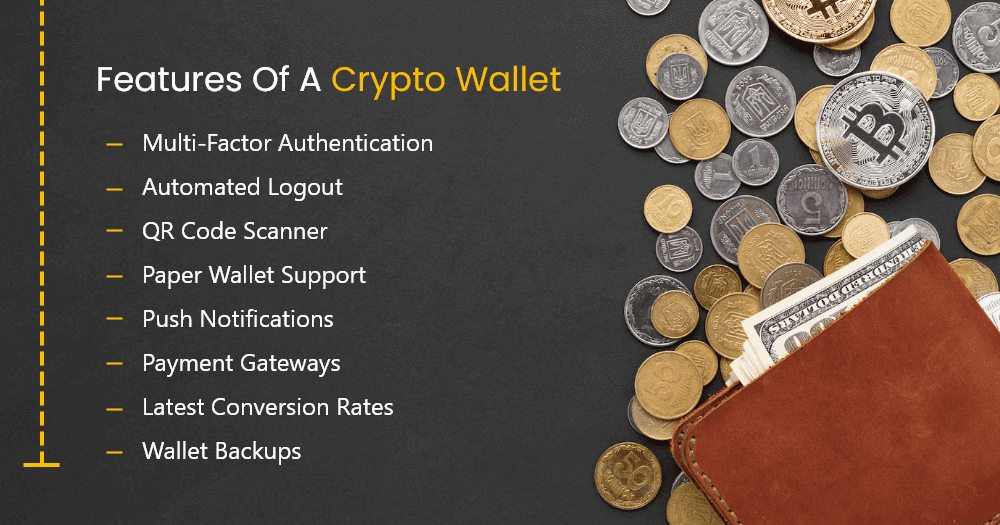
-
Multi-Factor Authentication
With the growing popularity of cryptocurrency wallets and many advanced wallets being developed, crypto wallets are prone to security attacks. Considering this, wallet developers must enable two-factor or multi-factor authentication. These authentication features add additional security apart from username and password that most conventional wallets do not provide.
-
Automated Logout
The most prominent sign of a safe and powerful crypto wallet is its ability to log out whenever suspicious activity is detected automatically. Wallet developers might think this feature can be annoying to wallet users; the same is required to reduce the wallet’s possibility of being hacked or granting access to outsiders. As a wallet developer, you can research the ideal time duration for inactivity. Once the duration exceeds, the app must automatically log out even when the app is closed.
-
QR Code Scanner
QR code scanner powers your crypto with speed, security, and simplicity, allowing the wallet developers to do transactions easily. When a wallet has a QR code scanner integrated, users can automate scanning and public key and thus complete the transactions with a single click.
-
Paper Wallet Support
Your crypto wallet must allow the users to quickly scan the QR code on a paper wallet for sending and receiving the funds or cryptos to the desired wallets.
-
Push Notifications
Push notification is an essential feature that keeps the wallet users alerted and notified of the wallet’s activities. This feature keeps users updated about everything in real time, from general notifications to updates about the latest wallet version.
-
Payment Gateways
Payment gateways are integrated into a crypto wallet, simplifying the buying and selling of cryptos for wallet users. Using the payment gateways, merchants can seamlessly accept payments in various cryptocurrencies such as Bitcoin, Binance coin, ETH, etc. Considering the ease and requirements of the merchants, most payment gateways these days support buying and selling cryptos, litecoin, bitcoin, Dogecoin, and more to stand apart from the other wallet alternatives.
-
Latest Conversion Rates
A cryptocurrency wallet is incomplete without being able to facilitate crypto transactions according to real-time currency conversion rates. That’s because a cryptocurrency wallet app allows users to do transactions in the same currency and multi-currency transactions such as crypto to crypto and crypto to fiat currencies.
-
Wallet Backups
For a crypto wallet to be advanced and worldwide popular, it must support the feature of easy and safe wallet backup. This facility allows crypto wallet users to back up their wallets safely in case of software or computer system failure. Generating backup on any device or SD card is highly beneficial, but wallet developers may ignore integrating storage tools like Google Drive or Dropbox into the crypto wallet ecosystem. By doing this, developers miss a great opportunity to make their wallet a mainstream solution.
Hire Blockchain Developer
What are The Tools and Technology Stack Required for Crypto Wallet Development?
The selection of tools and technology stack differs based on the types of wallet developers are planning to build, including the selection of features, user interface design, interoperability, etc. Following is an example of a technology stack that can work for most crypto projects.
-
For Mobile Crypto Wallet Development
Choosing a programming language for building a crypto wallet is pretty straightforward. If you are building an android-based crypto wallet, then choose Kotlin. If you seek to build an iOS app, proceed with Swift. Both of these programming languages are the most advanced and widely used Google and Apple-supported tool sets for coding the backend of your crypto wallet.
-
For Web Crypto Wallet Development
React and Node.js are the prevalent new-age web development languages or tools that offer a range of instruments trending in the market. With these programming languages, you can build advanced web-supported crypto wallets.
-
Multi-Platform Supported Wallet Development
Along with the mobile and web and mobile app supported crypto wallets, cross-platform supported crypto wallets are rising in demand. This type of wallet works seamlessly on mobile and the web. For this type of wallet development.
How to Create a Cryptocurrency Wallet?
With the right crypto wallet development plan, you can quickly build feasible and more relevant crypto for the targeted users. Let’s understand a step-by-step crypto wallet development process in this regard.
1. Do Extensive Research and Generate a Valid Wallet Development Idea
Not just the crypto wallet, developing a product or solution requires a well-defined idea. Practical product ideas often emerge when you perform competitive research and explore most crypto developers’ challenges. Generally, the following two are the reasons why someone will create a crypto wallet app:
- You have built a DeFi app and want to provide customers with an in-built wallet.
- You want to launch an independent crypto wallet with novel features.
2. Hire a Development Partner
Once you finalize a potentially demanding idea for your crypto wallet, the next step is to hire a trusted development partner. You can easily find a reliable blockchain app development company or software development agency that can build your wallet from initial ideation to finish. Ideally, you need the following specialists to develop your crypto wallet as expected.
- Product Managers–
- Project Coordinators-
- UX and UI Designers–
- Developers, Testers, and DevOps–
Product managers are the people who evaluate your existing product idea and add on their contribution for a better outcome. These managers will further inspect the technical aspect of your wallet’s project and align the same with the ROI goals. From the maintenance release, product managers are responsible for providing you with a finished product according to your plan.
Promoted managers are the ones who are more responsible for translating your product idea into a final product. Their roles and responsibilities include coordination with the designers, QA developers, DevOps, and other teams to put your vision into a practical product.
UX and UI designers are responsible for building an engaging user interface optimized per your target audience’s requirements. They help your wallet to act efficiently as a one-of-a-kind portal that acts as a gateway to the blockchain (where cryptos exist and run).
Software engineers or developers are responsible for designing the frontend and back end of your crypto wallets, making your crypto app available as a finished product. Then comes the role of testers, who will rest your product and identify the bugs. Once they unveil the bugs and vulnerabilities, the DevOps ensure uninterrupted operations on your product, along with helping future updates to happen smoothly.
3. Understand the Basics of Crypto Wallet Development and Blockchain
Blockchain and its underlying technology play a vital role in crypto wallet development. Therefore, you must learn and understand the various aspects of blockchain before starting the wallet app project. Blockchain is a revolutionary technology that consists of chains containing data, and each data block remains connected via chains, a cryptographic principle. Note that cryptocurrencies are blockchain-powered digital currencies that are run and managed on the blockchain.
4. Leverage Open-Source Libraries and Standard Cryptocurrencies
Since public blockchains power most cryptocurrencies, these are open-source. It saves you the time and resources required to build tools and libraries from scratch. You can leverage the free libraries and tools available for everyone, such as BitcoinJ SDK and Coinbase SDK.
- Coinbase SDK–
- BitcoinJ SDK–
- Use APIs–
A cross-platform Java library helps developers build crypto wallets like Coinbase wallet with customized features and user interface. This library facilitates the development of android and iOS cryptocurrency wallets with its extensive support for popular programming languages such as JavaScript, Ruby, Python, C++, etc.
An easy to use library with detailed documentation and is JVM-compatible. Furthermore, you can work with other languages like Javascript, Ruby, Python, C++, etc., while using this SDK.
If you plan to build a feature-rich crypto wallet, then using APIs is an excellent way to execute your project. Also, you can use distributed APIs as these allow you to easily synchronize the crypto wallet app with the desired blockchain ecosystem. Coinbase, Bitcore, and Factom are the popular APIs that help you complete the wallet-related necessary steps less than expected.
5. Select a Cloud Platform
As the next step, you must select a cloud platform for your crypto wallet app. Those building a web-based wallet can choose Paas (platform-as-a-service), but for mobile-based crypto wallet apps, you must opt for Baas (blockchain-as-a-service). You can choose BaaS products. Once you choose this, you need to integrate the cloud service in your app from renowned hosting companies such as Amazon, Azure, and Microsoft. Once you choose Baas, continue integrating their cloud service into your crypto wallet app.
6. Compile the Right Technology Stack
Refer to the technology stack discussed earlier in this article and choose the precise technology stack. For example, you will require Node.js or Angular.js and HTML and CSS3 to create a scalable web-based crypto wallet. On the other hand, if you plan to build a native crypto web application, you should choose one between Java and Kotlin. Lastly, Swift or objective-C is the right technology stack for iOS crypto wallet apps.
7. Ensure Security
Accentuating security is vital for building any Bitcoin wallet, whether a web or mobile-based wallet. To ensure that your wallet has top-notch security, you must add an extra security layer to the wallet by integrating features such as face recognition, 2FA-fingerprint, and hardware authentication. Given that application security parameters change over time, wallet developers must perform continuous security updates to identify the bugs and fix the issues if spotted quickly.
8. Track your Competitors
Undoubtedly, your cryptocurrency wallet app must stand apart from the thousands of other alternatives. The best way to ensure the uniqueness of your app is to track competitors, see what features their app has to offer, and think out of the box to introduce a highly feasible feature for your wallet app.
9. Start Building your Crypto Wallet.
At this stage, when you have everything in place, you can begin with your crypto wallet development project while keeping the following points in mind:
- Be clear about the initial features you want to introduce in your crypto wallet.
- Write, compile and test application code to integrate it into your database.
- Design a simple-to-use and visually appealing user interface for the wallet.
- Conduct extensive testing and optimization before launching your wallet.
10. Release and Maintenance
Releasing a product or a software solution is the final stage of development. Once the developers test and optimize the product on the testnet, they deploy the solution to the mainnet,making it live across the decentralized blockchain environment. This way, users can sign up and use the wallet.
What is the Estimated Cost of Developing a Crypto Wallet?
Although the budget for building a crypto wallet differs from project to project, the estimated cost of building your crypto wallet with novel features and functionalities is between $120000 to $200000. You can better execute your idea by starting it off from the discovery phase (also widely known as the pre-flight workshop) and then formalizing your project idea into a rapid prototype. Crypto wallet development costs through this method usually cost approximately $20,000. You can request a quote from any reliable crypto wallet development company for a more precise idea about the wallet development cost.
Crypto Wallet Development Services by The NineHertz
At NineHertz, we are dedicated to building on-demand customized blockchain solutions for enterprises, startups, and scale-ups. Our team has extensive experience building all types of crypto wallets, mobile wallet, web wallets, and wallet extensions per user-specific requirements. Following is a brief explanation of our crypto wallet development services:
- Mobile wallet development
- Desktop wallet development
- Wallet as browser extensions
How do We Execute your Crypto Wallet Development Project?
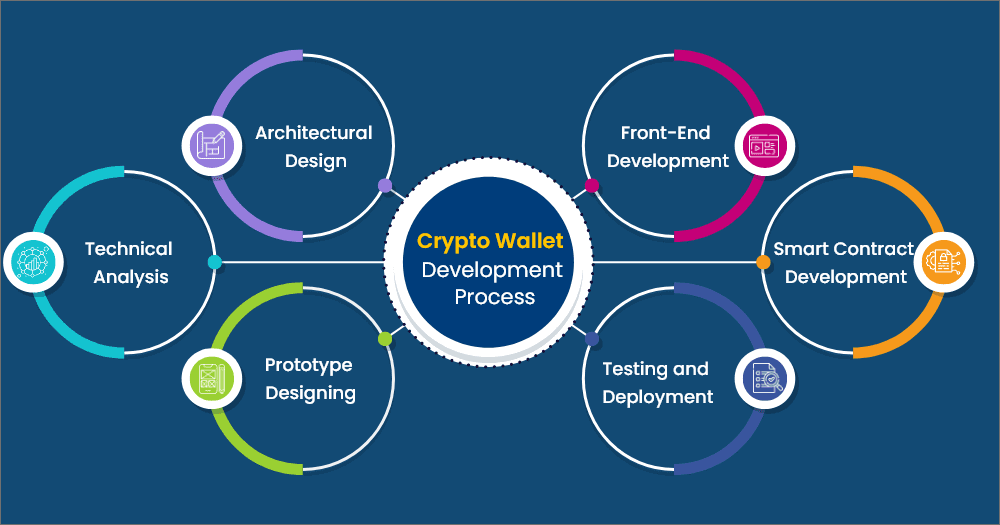
-
Technical Analysis
-
Architectural Design
-
Prototype Designing
-
Front-End Development
-
Smart Contract Development
-
Testing and Deployment
Our team begins working on your crypto wallet development project by reviewing your blockchain initiatives’ technical and commercial aspects to determine the wallet’s function and requirements.
Architectural designing of your wallet is when we lay out the interactions among the frontend development, backend development, data storage retrieval, etc.
Under prototype designing, our developers define the wallet’s appearance through a basic layout of the UX/UI elements in a low-fidelity prototype. Once we have your approval, receiving your approval, we will produce the high-fidelity design.
For frontend and backend development, our blockchain professionals work with frameworks like Angular, React, React-Native, and Ionic, as well as programming languages including JavaScript, TypeScript, Go, Solidity, Node.js, and Go.
Based on your crypto project-specific requirements, we design and create smart contracts to allow the wallet’s functions to add wallet operations such as bundle transactions, account recovery, transfer restrictions, and more while allowing these functions to work correctly.
After testing the product thoroughly on the test networks to remove bugs or omissions, our team proceeds to deploy the crypto wallet to the blockchain to make the product available to the users.
The details we discussed in this article will guide you on how to create a crypto wallet. However, you can connect with the team at NineHertz to discuss your project requirements and get suggestions on building your customized crypto wallet with advanced features.
Conclusion
Ever since the web2-based digital wallets have gained prominence among all of us, we have gotten into the habit of handing our funds, assets and confidentials to third parties. Now that blockchain has brought revolution with decentralized technology, we can take custody of our assets and better manage the funds through cryptocurrency wallets. Hence, if someone chooses to use a crypto wallet instead of a centralized wallet, he or she chooses to have a novel experience.
FAQS
1. What is a Crypto Wallet?
A decentralized version of digital wallet that is designed to store, manage and share cryptocurrencies to desired address.
2. Can a Wallet Company Access My Confidential Information?
No, data in the crypto wallet is completely safe as it is stored in the decentralized ecosystem of blockchain.
3. Do I Need to Maintain Secrecy on My Private Key?
Yes, a private key is like the login credentials of your wallet that anyone can use to access and misuse your wallet.
4. can I Create My Own Crypto Wallet
yes, you can create your own crypto wallet, lets take a quick steps for creating a Cryptocurrency Wallet
- Set up a wallet API to manage permissions. You can download the code from platforms like GitHub.
- Create a password for the wallet and keep it private.
- Create a private key so that only you have access to the money.
- Try to do outgoing transactions.
- Create a new wallet address.
- Thoroughly evaluate the user interface.
- Store some funds in it.
Great Together!
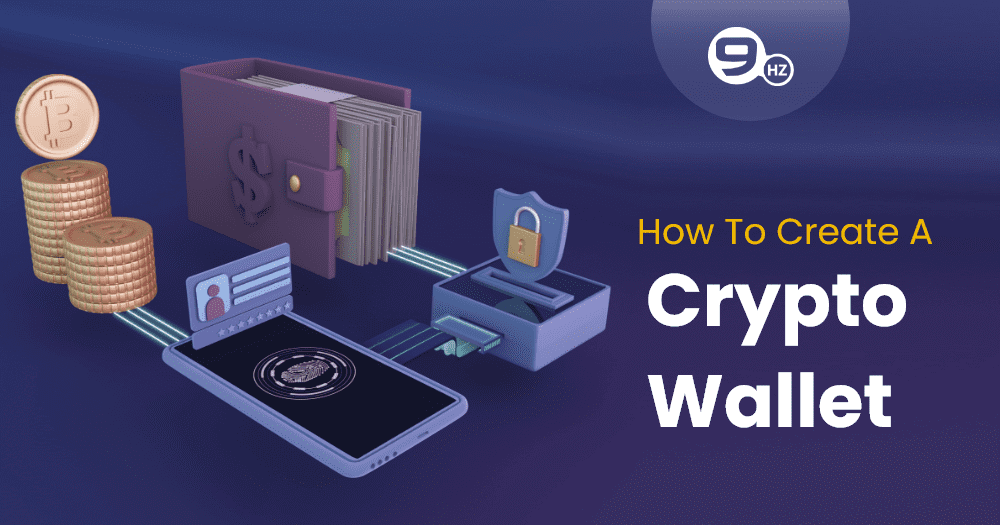

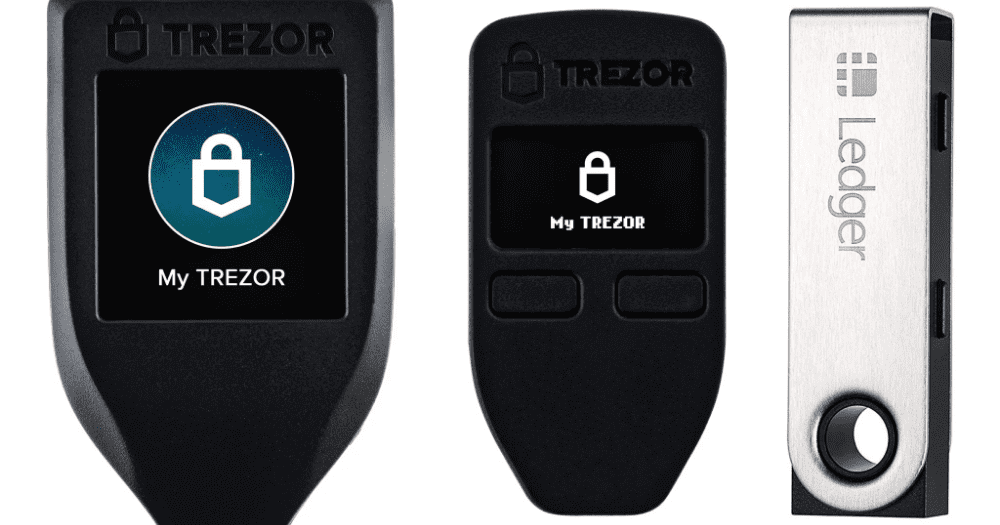
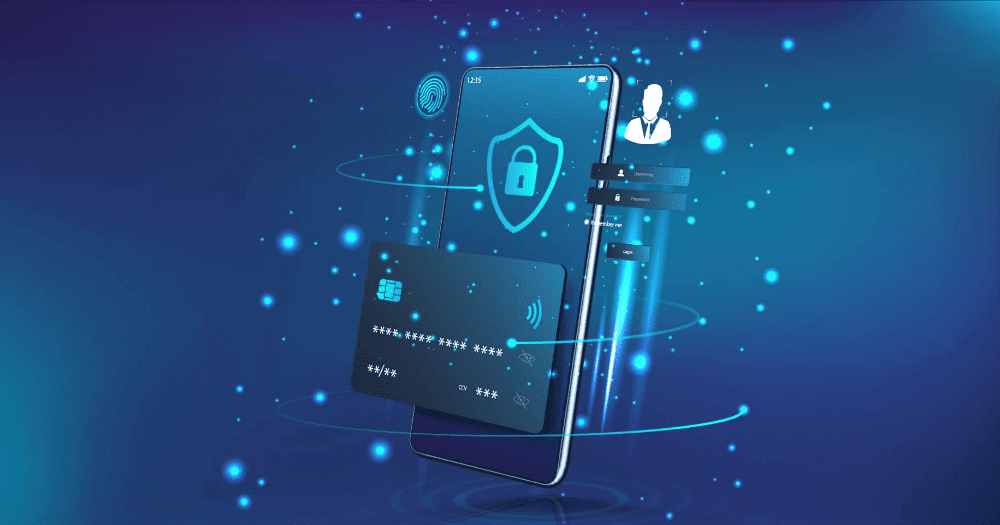
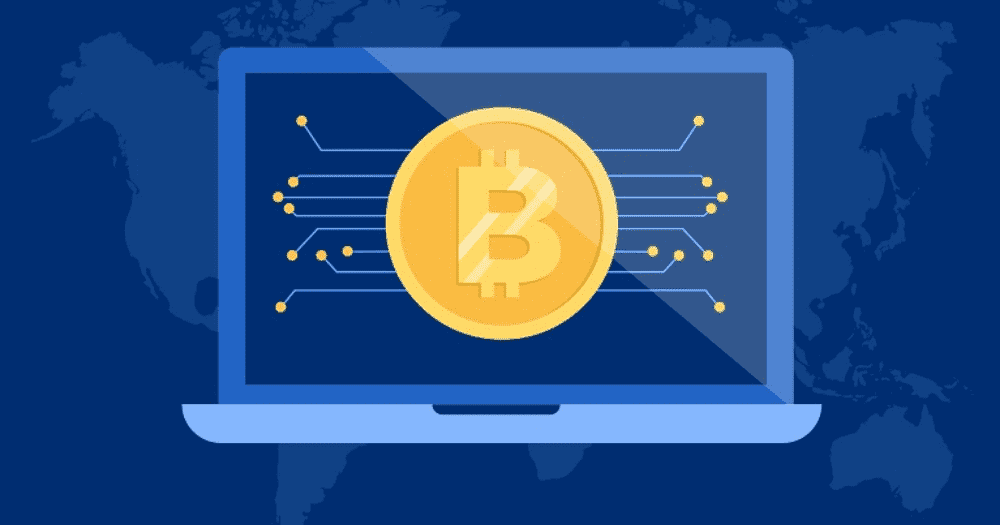
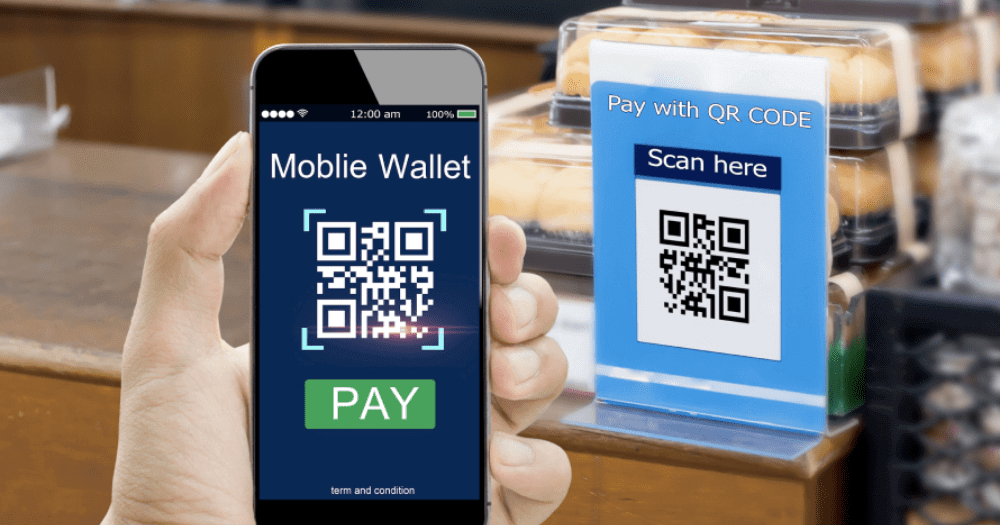
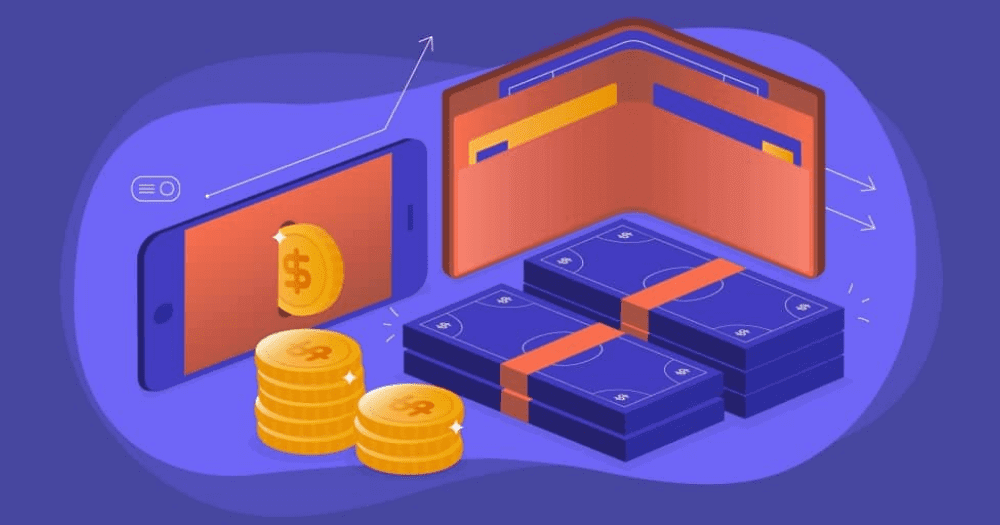
![How to Create an App like Careem? [Cost in 2025]](https://theninehertz.com/wp-content/uploads/2024/09/how-to-create-an-app-like-careem.webp)

![How to Create an AI-Powered Wellness App? [2025 Guide]](https://theninehertz.com/wp-content/uploads/2025/11/how-to-create-an-ai-powered-wellness-app.webp)





